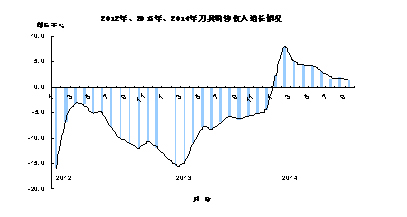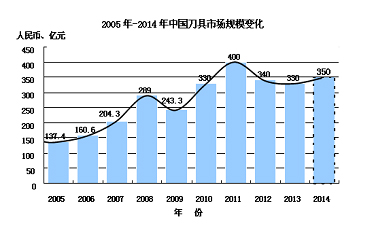Abstract China's tool market has experienced a severe baptism of two consecutive storms. This year, Dawning began to appear, and the sales performance in the first three quarters maintained a steady and good trend. Figure 1 is a monthly sales report from the member companies of the tool club from January 2012 to September 2014...
China's tool market has experienced the rigorous baptism of two consecutive storms, and this year, the beginning of the dawn, the sales performance in the first three quarters has maintained a steady and good trend. Figure 1 is a graph showing the year-on-year growth (decrease) of the company's sales revenue based on the monthly sales report data of the member companies of the tool club from January 2012 to September 2014. The enterprises participating in the monthly report account for about 40% of the members. Although the number is small, the composition is relatively stable. As an analysis of the industry's sales trends, the comparability is better and more timely. 
Figure 1 Curve of sales revenue of tool companies from 2012 to 2014
According to the information currently available, it is predicted that the tool sales of domestic enterprises will increase by about 5% in 2014, and the sales performance of foreign-funded tools enterprises in China will continue to lead, with an increase of about 8%. It is initially predicted that the domestic tool market will be about RMB 35 billion this year (see Figure 2), with imports of RMB 12.5 billion and domestic production of RMB 22.5 billion, a total increase of around 6%. In terms of tool exports this year, the tool has rebounded significantly, and the gauges still have a slight decline.

Figure 2 China's tool market scale change from 2005 to 2014
Looking back at the ups and downs of the domestic tool market in the past three years, we can figure out some veins and summarize some lessons:
First, the tool market contracted sharply in 2012. In fact, it was caused by the government's tightening monetary policy to curb inflation in 2011. However, due to the delay in transmission, the manufacturing industry has not noticed that the crisis is approaching and the tool procurement contract is fulfilled as usual. Until the beginning of 2012, the main engine factory suddenly found that the order contract was greatly reduced, and emergency measures were taken to protect the cash flow, which greatly reduced the procurement of tools. Imported tools are expensive, and cutting orders is the first to bear the brunt. Foreign businessmen who have been hit by accidents have asked the association how the Chinese manufacturing industry is doing? I changed my face overnight. However, the 2012 economic data released by the Bureau of Statistics is even more confusing: GDP increased by 7.8% over the previous year, and the added value of industrial enterprises above designated size increased by 10%. Although it has fallen back from the past, it is still among the best in the world. Under such a macroeconomic background, it is impossible to explain from any angle that the tool market will have a 15% dip in the past. It now appears that the real reason for the sudden emergence of the tool market in the cold winter is the consequences of excessive government regulation in the economic transformation.
Second, in 2013, the sales situation of the tool industry really turned around. After the new government took office, it made major adjustments to China's macroeconomic policies. In the face of the downward pressure on the economy, the country has not issued a large-scale stimulus plan again, nor has it engaged in macroeconomic regulation and control. Instead, it has clearly stated that reform and innovation are the inexhaustible motive force for development, and a series of reforms of government functions as the center and vigorously promote the administrative management system. The "combination boxing" of reform pointed out the direction of reform. Premier Li Keqiang has repeatedly stressed that in the face of the new situation and new changes in economic development, we must maintain a certain strength, calmly respond, comprehensively implement policies, and make precise efforts. This correct policy orientation has a huge impact on national manufacturing enterprises and tool companies. The first is to lose the illusion that the government is expected to rescue the market again, followed by a group of enterprises that are at the forefront of development, recognizing that the country’s macroeconomic development has already Entering the transformation track and consciously accelerating the pace of development of “adjusting structure and promoting transformationâ€, the actions of these leaders have played an exemplary role and promoted the majority of industry enterprises. It should be pointed out that in 2013, tool sales began to stabilize and stabilized, which was achieved in the case of low-end tool sales continued to decline. It shows that the high-end tools urgently needed in modern manufacturing industries have recovered their strong demand, and the pace of localization is also accelerating. The scale of import substitution has further expanded. The market situation is forced to make a group of tool enterprises combine stable growth and adjustment structure, and low-end losses are high-end, and achieve sustainable development. In this way, the product structure adjustment of the tool enterprise saw results in the beginning of 2013, and continued to move forward along this road in 2014, and it achieved good results in the sales performance of the whole industry.
Third, the development of the ups and downs of the tool market in the past three years has been relatively clear from the industry as a whole. Generally speaking, the excessive tightening policy in 2012 has led to a sharp dip. In 2013, the reform of the New Deal introduced sales to stabilize and stabilize. In 2014, the structural adjustment was strengthened. Stable and rising. However, for every enterprise, the development is still very uneven. Although the overall market situation is improving this year, 40% of enterprises are still in the downward channel. Of course, the situation is very different. Some are stepping up the adjustment structure and reserve the stamina for development. It is temporarily falling back. However, there are still some companies that have low overall competitiveness and are worried about the new changes in the market. In the past period of rapid economic growth, under the traction of strong demand, the products are in short supply regardless of the high-end and low-end, so almost all enterprises can catch a ride and have a better life. However, the current situation has undergone fundamental changes. China's economic development has entered a new normal. The government has to change its functions, let enterprises return to the dominant position of the market, optimize the allocation of resources through competition, and implement the survival of the fittest. The protection role of the government will be greatly reduced. For each enterprise, the competitiveness construction must mention the primary position. Improving competitiveness will be the only guarantee for the survival and development of the enterprise in the future. (Author: Tools China Machine Tool Industry Association Branch Secretariat Shen bolstering departure)
Wireless pressure transmitter is high accuracy and low consumption wireless pressure measuring device. NB-lot LORA GPRS wireless spread spectrum communication technology is used for remote data transmission. It is simple to install, without onsite wiring,which save construction cost, especially suitable for not easy wiring and unable to power supply.
Wireless Pressure Transmitter,Wireless Pressure Sensor,Wireless Pressure Transducer,Wireless Differential Pressure Transmitter
Xi'an Gavin Electronic Technology Co., Ltd , https://www.gamicos-meas.com